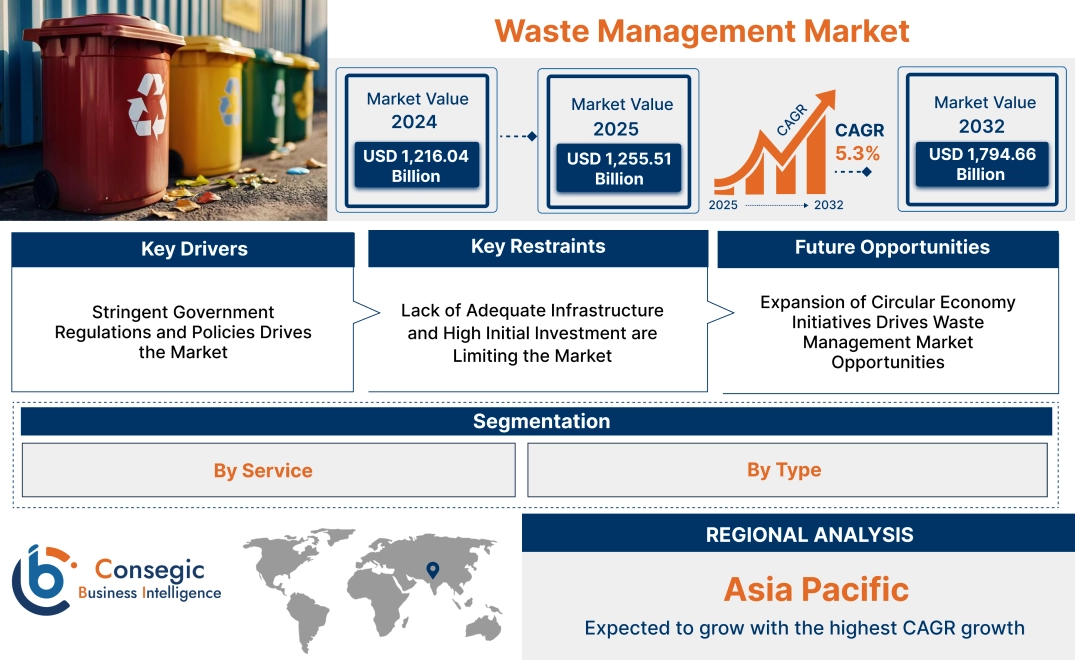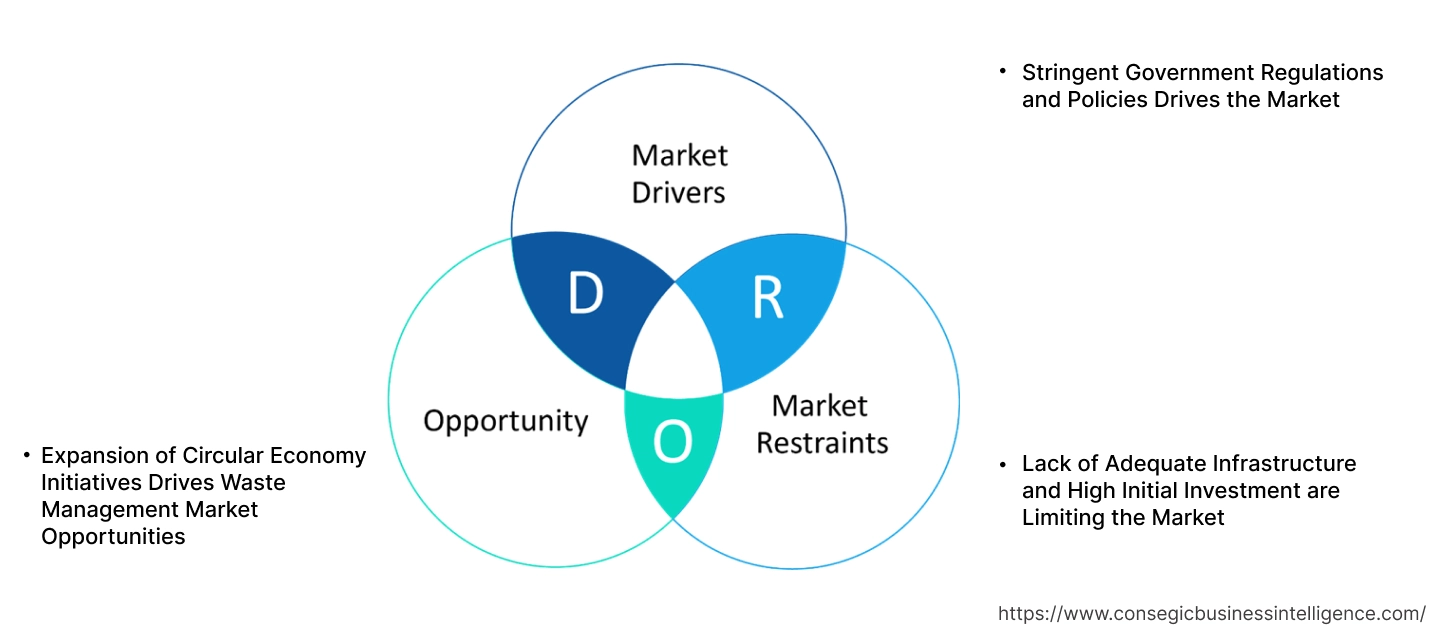Waste Management Market Size:
Waste Management Market Size is estimated to reach over USD 1,794.66 Billion by 2032 from a value of USD 1,216.04 Billion in 2024 and is projected to grow by USD 1,255.51 Billion in 2025, growing at a CAGR of 5.3% from 2025 to 2032.
Waste Management Market Scope & Overview:
Waste management encompasses the systematic processes of collecting, transporting, processing, recycling, or disposing of waste materials. The primary goal is to minimize the adverse effects of waste on human health and the environment while maximizing resource efficiency. The major impact of high waste generation includes environmental pollution and increased greenhouse gas emissions which results in climate change and risks to human health. Further, the key trends driving the market include increasing focus towards circular economy and rapid advancements in waste treatment technologies. Furthermore, stringent government regulations promoting sustainable waste treatment practices and growing environmental awareness are significantly driving the waste management market growth.
How is AI Impacting the Waste Management Market?
AI is transforming the waste management market by optimizing every stage from collection to recycling. AI-powered sensors in smart bins monitor fill levels, enabling route optimization for collection vehicles, drastically reducing fuel consumption, emissions, and operational costs. In sorting facilities, robotic arms equipped with AI vision systems precisely identify and segregate various waste materials, significantly boosting recycling rates and purity while minimizing contamination. Predictive analytics further enhance efficiency by forecasting waste generation patterns, allowing for proactive resource allocation and infrastructure planning. This data-driven approach fosters a more sustainable and cost-effective waste management ecosystem, addressing pressing environmental challenges.
Waste Management Market Dynamics - (DRO) :
Key Drivers:
Stringent Government Regulations and Policies Drives the Market
Stringent government regulations and policies are significant drivers for the waste management market. Environmental protection laws, recycling mandates, and restrictions on landfill disposal compel industries and municipalities to adopt more sophisticated waste treatment practices. Further, Extended Producer Responsibility (EPR) policies shift the burden of end-of-life product management to producers, fostering recycling and reuse initiatives. Furthermore, bans on single-use plastics and regulations on hazardous waste handling necessitate specialized waste treatment services and infrastructure development.
- For instance, in August 2022, Government of India introduced battery waste management rules, 2022, which mandate that producers are responsible for collecting and recycling all battery types including EV, portable, automotive, and industrial. Further, Extended Producer Responsibility (EPR) system encourages new recycling industries, technological advancements, and the use of recycled materials in new batteries, reducing reliance on raw materials.
Thus, increasing governmental regulation and initiatives driven by growing awareness contribute significantly to the waste management market size.
Key Restraints:
Lack of Adequate Infrastructure and High Initial Investment are Limiting the Market
The lack of adequate infrastructure and high initial investment are significant limitations in the market. The insufficient waste collection systems, lack of treatment facilities, and a shortage of disposal sites are major concerns particularly in developing nations. Further, establishing modern waste treatment infrastructure, including recycling plants, waste-to-energy facilities, and advanced sorting technologies, demands substantial capital expenditure. Furthermore, the high costs associated with land acquisition, technology procurement, and operational logistics create a significant barrier to market entry. Thus, infrastructural deficit and financial constraint hinder the adoption of sustainable waste treatment practices which in turn limit the waste management market growth.
Future Opportunities :
Expansion of Circular Economy Initiatives Drives Waste Management Market Opportunities
The increasing global emphasis on circular economy initiatives is creating significant opportunities within the waste treatment market. There is a shift towards a system prioritizing resource reuse, repair, refurbishment, and recycling which directly fuels the demand for innovative waste treatment solutions. Further, companies specializing in material recovery, advanced recycling technologies, and product lifecycle extension are expected to benefit from these initiatives.
- For instance, in November 2024, US Environmental Protection Agency released “National Strategy to Prevent Plastic Pollution” which outlines key objectives including reducing pollution from production, fostering innovative material and product design, decreasing waste generation, improving waste treatment practices, and others.
Therefore, increasing number of circular economy initiatives worldwide drives the waste management market opportunities.
Waste Management Market Segmental Analysis :
By Service:
Based on the service, the market is segmented into collection and disposal.
Trends in the Service:
- Increasing transition towards electric vehicles (EVs) and compressed natural gas (CNG) vehicles for transporting waste drives the waste management market trends.
- Increased adoption of automated sorting technologies such as optical sorters, AI-powered robotic arms, and sensor-based sorting is expected to drive waste management market size.
Collection accounted for the largest revenue share in the market in 2024.
- Increased adoption of GPS tracking, smart sensors in bins, and AI-powered route optimization software drives the waste management market share.
- Further, there is growing implementation of automated side-loader and front-loader trucks to reduce labor costs and improve speed and safety which in turn drives the waste management market.
- Furthermore, emergence of app-based platforms for on demand collection services drives the waste management market trends.
- For instance, in November 2023, Biffa, a UK leader in sustainable waste treatment acquired Hamilton Waste and Recycling Limited (HWR). The acquisition is expected to expand Biffa's capabilities in the construction and demolition sector and strengthen its commitment to low-carbon collections and material processing
- Thus, as per waste management market analysis, digitalization, automated collection system, and on-demand collection service are driving the market trends.
Disposal is anticipated to register the fastest CAGR during the forecast period.
- Increasing emphasis on disposal solutions like recycling, composting, anaerobic digestion, and waste-to-energy drives the waste management market share.
- Further, combining multiple disposal technologies within a single facility to maximize resource recovery and minimize landfill waste drives the waste management market demand.
- Furthermore, significant investment and development in chemical recycling processes that can break down plastics into their basic monomers drives the market.
- Therefore, based on analysis, sustainable disposal methods, integrated waste treatment facilities, and chemical recycling is anticipated to boost the market during the forecast period.
By Type:
Based on the type, the market is segmented into municipal waste, industrial waste, and hazardous waste.
Trends in the Type:
- Increasing efforts to reduce the generation of single-use plastics and non-recyclable packaging which in turn drives the waste management market demand.
- Growing adoption of composting and anaerobic digestion technologies drives the market.
Industrial waste accounted for the largest revenue share of 54.91% in the year 2024.
- Growing industrial activities across emerging economies like India and China drives the waste management market.
- Further, increasing environmental concerns and stringent regulations are driving the waste management industry.
- Furthermore, growing use of sensors, IoT, and data analytics to monitor waste generation in industries is expected to drive the waste management market expansion.
- For instance, in June 2023, SUEZ acquired 60% stake in APBB which is a leading Czech Republic-based company specializing in converting waste into biogas through anaerobic digestion. Moreover, the acquisition allows SUEZ to expand its operations in the Czech Republic beyond the water sector into municipal and industrial waste treatment and green energy production.
- Thus, as per waste management market analysis, growing industrial activities, stringent regulations, and digitalization are driving the market.
Hazardous waste is anticipated to register the fastest CAGR during the forecast period.
- Increasingly stringent environmental regulations and stricter enforcement regarding the handling, transportation, treatment, and disposal of hazardous waste drives the market.
- Further, more rigorous waste characterization and risk assessment procedures propels the waste management market expansion.
- Furthermore, growing trends of industrialization and urbanization are resulting in increased growth in hazardous waste which in turn drives the market.
- Thus, as per analysis, stringent environmental regulations waste characterization and growing industrialization is anticipated to boost the growth of the market during the forecast period.
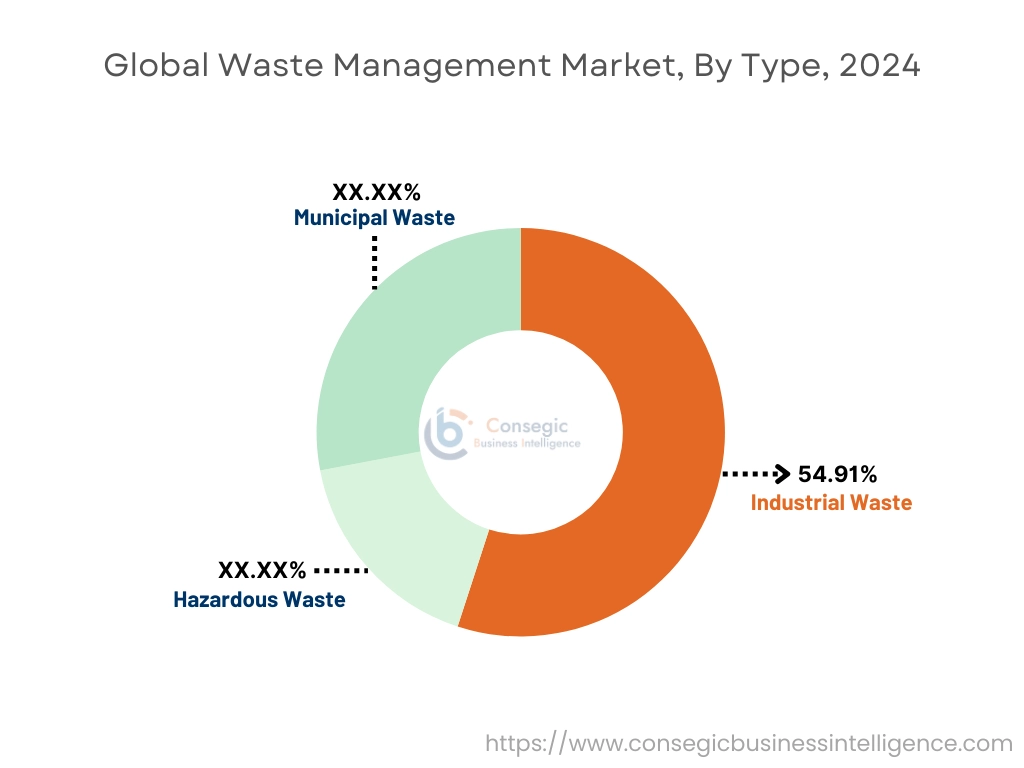
Regional Analysis:
The regions covered are North America, Europe, Asia Pacific, Middle East and Africa, and Latin America.
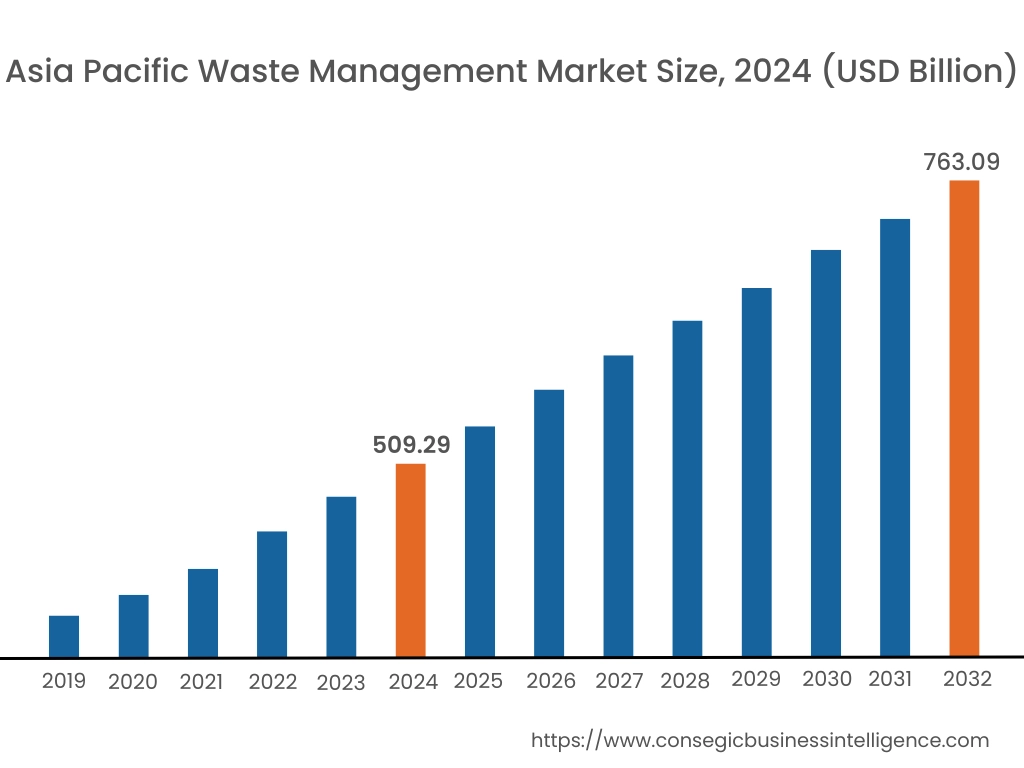
Asia Pacific region was valued at USD 509.29 Billion in 2024. Moreover, it is projected to grow by USD 526.49 Billion in 2025 and reach over USD 763.09 Billion by 2032. Out of this, China accounted for the maximum revenue share of 32.64%. The market growth for waste handling is mainly driven by rapid urbanization and industrialization, leading to a significant increase in waste generation across the region.
- For instance, in June 2024, SUEZ announced three new water projects in Asia, highlighting its focus on digital solutions, seawater desalination, and water reuse. These projects in Singapore, China, and the Philippines showcase SUEZ's commitment to innovative water management and building climate resilience through partnerships and circular solutions in both municipal and industrial sectors.
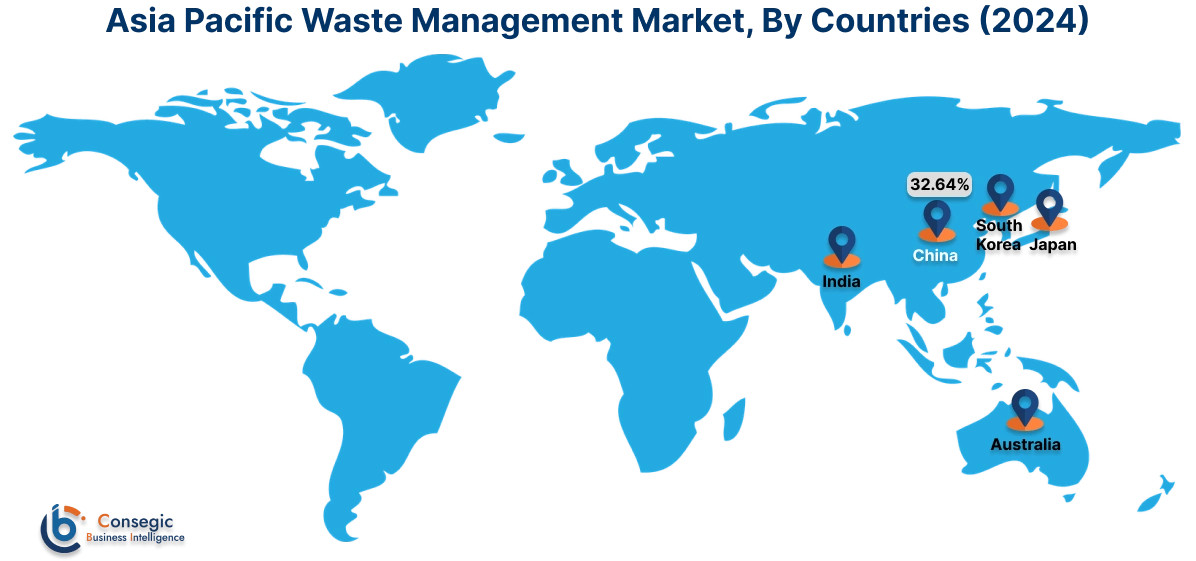
North America is estimated to reach over USD 427.67 Billion by 2032 from a value of USD 290.91 Billion in 2024 and is projected to grow by USD 300.25 Billion in 2025. The North American market is primarily driven by increasing environmental awareness and stricter government regulations which promotes sustainable waste handling practices
- For instance, in March 2022, Ascend Elements a lithium-ion battery recycling and engineered-materials company, chosen by SK Battery America (SKBA) to recycle lithium-ion battery manufacturing scrap from SKBA's Georgia facility.
The regional trends analysis depicts that increasing government regulation, focus towards circular economy, and presence of large number of players in Europe is driving the market. Additionally, the factors driving the market in the Middle East and African region are rapid population growth, urbanization, and technological advancement in waste handling and treatment. Further, based on analysis, increasing waste generation and growing trend towards public-private partnerships to boost investment and improve the efficiency of waste treatment infrastructure is paving the way for the progress of market trends in Latin America region.
Top Key Players and Market Share Insights:
The global waste management market is highly competitive with major players providing solutions to the national and international markets. Key players are adopting several strategies in research and development (R&D), product innovation, and end-user launches to hold a strong position in the waste management industry. Key players in the global waste management market include-
- Veolia (France)
- SUEZ Group (France)
- Urbaser (Spain)
- Republic Services (US)
- Stericycle (US)
- FCC Environmental Services (US)
- Clean Harbors (US)
- Biffa (UK)
- Biomedical Waste Solutions (US)
- Valicor (US)
Recent Industry Developments :
Partnership and Collaboration:
- In February 2024, Cirba Solutions, a leading battery recycling and materials company, has signed a Memorandum of Understanding (MOU) with EcoPro Co Ltd, a global leader in lithium-ion battery cathode materials. The collaboration aims to enhance innovative aspects of the lithium-ion battery recycling industry.
Merger and Acquisition:
- In November 2024, Biffa, finalized the acquisition of Keenan Recycling, a commercial food waste collection provider with operations across England, Scotland, and Wales. The acquisition is expected to enhance Biffa's food waste collection capabilities.
- In December 2024, Veolia Nuclear Solutions successfully acquired Daher Nuclear Technologies (DNT) which expands company’s nuclear waste management capabilities, especially in France. The move aligns with Veolia's GreenUp strategic plan, focusing on growth in hazardous waste management.
Waste Management Market Report Insights:
| Report Attributes | Report Details |
| Study Timeline | 2019-2032 |
| Market Size in 2032 | USD 1,794.66 Billion |
| CAGR (2025-2032) | 5.3% |
| By Service |
|
| By Type |
|
| By Region |
|
| Key Players |
|
| North America | U.S. Canada Mexico |
| Europe | U.K. Germany France Spain Italy Russia Benelux Rest of Europe |
| APAC | China South Korea Japan India Australia ASEAN Rest of Asia-Pacific |
| Middle East and Africa | GCC Turkey South Africa Rest of MEA |
| LATAM | Brazil Argentina Chile Rest of LATAM |
| Report Coverage |
|
Key Questions Answered in the Report
How big is the waste management market? +
The waste management market is estimated to reach over USD 1,794.66 Billion by 2032 from a value of USD 1,216.04 Billion in 2024 and is projected to grow by USD 1,255.51 Billion in 2025, growing at a CAGR of 5.3% from 2025 to 2032.
What specific segmentation details are covered in the waste management report? +
The waste management report includes specific segmentation details for service, type, and regions.
Which is the fastest segment anticipated to impact the market growth? +
In the waste management market, hazardous waste is the fastest-growing segment during the forecast period.
Who are the major players in the waste management market? +
The key participants in the waste management market are Veolia (France), SUEZ Group (France), FCC Environmental Services (US), Clean Harbors (US), Biffa (UK), Biomedical Waste Solutions (US), Valicor (US), Urbaser (Spain), Republic Services (US), Stericycle (US) others.
What are the key trends in the waste management market? +
The waste management market is being shaped by several key trends including growing environmental awareness, technological advancement in waste treatment, and increasing government regulations.
